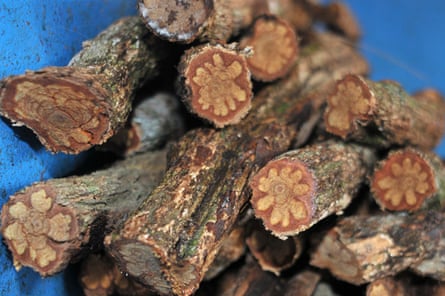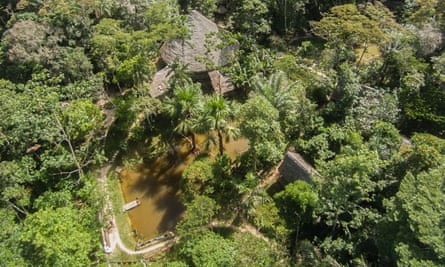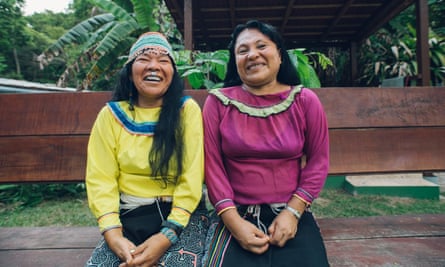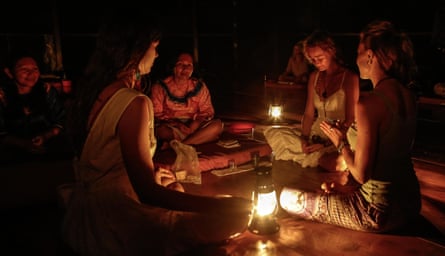Imagine you’re in a simple wooden house in the suburbs of Iquitos, the largest city in the Peruvian Amazon, and drinking a bitter, dark brown liquid. The lights go off. Half an hour later the most extraordinary visions begin.
Fast forward four hours and it’s all over. You’ve seen Christ and Buddha, and you’ve almost been moved to tears by the incantations of curandero (healer) Juan Tangoa Paima and all the deep-throat vomiting you’ve been doing in his garden.

That was my first experience, in 2005, of what has come to be known internationally as ayahuasca. Made from a mixture of an Amazonian vine known as Banisteriopsis caapi and usually at least one other plant (in Peru mostly chacruna), ayahuasca is a plant medicine that has been used in the Amazon for centuries for healing and spiritual purposes.
“It’s about connecting to the natural world,” says Romulo Sinuiri Ochavano, a Shipibo curandero who drinks ayahuasca to communicate with the spirit world and understand his patients’ illnesses. “It’s one technique for us. It’s the same as a doctor in a clinic with equipment that enables him to see if someone’s ill. Where’s the illness? The curandero sees which plants are good for curing that person.”

Traditional use involves only the curanderos drinking, according to Luis Eduardo Luna, a Colombian anthropologist and pioneer ayahuasca researcher. He says it has mostly been used for divination, such as diagnosing psychosomatic or ethno-specific illnesses with no western equivalent, or for making contact with the spirit world.
“The manifestation [of the psychosomatic illness] may be you lose your voice or have a physical problem, or in children through diarrhoea and vomiting,” says Luna. “Or somebody who has very bad luck in love or business … they would go to a curandero who will take the ayahuasca, give the patient ritual baths and energy, and protect them.”

Over the last 25 years ayahuasca has gone global, with thousands of people learning about it, and drinking it too. Curanderos are travelling abroad and ayahuasca is being exported. In Peru, major centres include the Cusco region and the cities of Pucallpa and Tarapoto, but it is Iquitos that attracts most interest. Every year thousands descend on the city, where centres offering ayahuasca have sprung up in the surrounding forest, while lodges offering “jungle tours” or “nature tours” include ayahuasca as well. The majority of visitors are foreigners.
Estimates of the number of centres in the Iquitos region offering ayahuasca vary from 30 to 100. Then there are jungle lodges and the curanderos living in the city, like Juan Tangoa Paima, and surrounding villages. The latter cater primarily for locals, though visitors can seek them out too.

Why are so many foreigners, particularly westerners, coming to Iquitos to drink ayahuasca? Some are seeking healing: for depression, alcohol-related issues, tobacco and drug addictions, arthritis, diabetes, skin diseases, cancer and more.
“Most of the treatment we’re carrying out is for trauma,” says Matthew Watherston, founder of the Temple of the Way of Light, a centre two hours from Iquitos. “The drive is often the crises that people feel in day-to-day life, manifested on a psychological, emotional or physical level. Ultimately, these are all symptoms; the origin, typically, comes from an energetic imbalance or disorder.”

Others drink ayahuasca because they’re curious and want to learn about it, or they’re looking for a new direction in life. Then there are those who, attracted by the often extraordinary visions, think it’s another tourist activity or recreational “drug.” That’s an idea many experienced with ayahuasca vehemently dismiss.
“If anyone thinks it’s in the same category as a cruise, well, the first drink would quickly change their minds,” says Peter Gorman, a journalist offering trips into the forest that include swimming with dolphins, foraging for wild food, hiking and ayahuasca. “It’s very serious medicine; very deep, very quick.”

Those after just a high aren’t welcome at some centres. Omar Gomez, from the Rainforest Healing Center, says he turns away 60% of potential visitors: either because they have problems that ayahuasca doesn’t mix with (such as schizophrenia) or because they’re not sufficiently serious about it.
“We do an intense screening process to make sure we don’t have any psychedelic tourists,” says Gomez. “Right now the ayahuasca industry is booming. But we want to make sure that the people who come are people that have a strong intention and desire to heal.”

Fundamental to ayahuasca’s appeal is that, unlike western medicine, it is believed to address the true causes of illness and make no distinction between mind and body. Ayahuasca practitioners see the physical manifestation of some mental, emotional, psychological or energetic disorder.
Reports of successes are common, particularly with depression, traumas and addictions. Brendan, a former US marine, was overweight and suffering from radiation poisoning, hypothyroidism, and nerve damage to his left leg after a training accident, and massive guilt after not serving in Iraq. But 12 days at the Temple transformed his life; it got him off the oxycontin and other medication he had been taking daily for years. He says he lost more than 45kg, his thyroid gland now functions normally, and he is “fully healed” from the radiation.
“When I left the Temple I went to a Veterans Affairs hospital in the US and had blood tests; everything was functioning normally, something they said would be impossible,” says Brendan, who now lives in Iquitos and has opened his own centre, The Sanctuary of Renana, offering free treatment to other veterans. “My doctor almost mocked me when I told him I was coming out here but when he saw the results of the tests he became fascinated.”

In 2013, the International Centre for Ethnobotanical Education, Research and Service (ICEERS) issued a report on ayahuasca saying that clinical trials showed it to be “physiologically very safe”. One of the report’s signatories was Jordi Riba, a Spanish pharmacologist at the Sant Pau hospital in Barcelona, who has researched ayahuasca for years.
“There’s preliminary evidence that it has the potential to change life attitudes for the better in cases of drug addiction, depression and trauma,” says Riba.
The options for drinking ayahuasca in and around Iquitos (in terms of prices and packages) vary enormously. The Temple offers nine-day, 12-day, three-week and month-long retreats, mainly for large groups, with prices ranging from $2,000 to $3,300 per person, while the Rainforest Healing Center, approximately two hours from Iquitos, offers seven- and 10-day retreats for small groups costing $995 and $1,495 per person respectively.

Then there are options such as the Sachamama Botanical Garden, 90 minutes from Iquitos, where one week’s stay and three ceremonies costs $650, or you can drop in for a ceremony and thrash out a price when you arrive. In addition, there are also curanderos such as Tangoa Paima, who I paid 40 Peruvian soles ($12) for one ceremony in 2005 and $60 for another ceremony last year.
Despite many positive experiences, there are numerous things to watch out for, and anyone interested in drinking ayahuasca should do as much research as possible. In Iquitos, there are reports of increasing numbers of people calling themselves curanderos, or offering ayahuasca while knowing nothing about it, as well as sexual assaults on women. Some people have had terrifying experiences and violent reactions, and over the last decade there have been ayahuasca-associated deaths.
One tragedy, in December 2015, was reported – or rather, misreported – by the mainstream media. A Canadian man, Joshua Andrew Freeman Stevens, killed Briton Unais Gomes after apparently being attacked by him during an ayahuasca ceremony at Phoenix Ayahuasca near Iquitos. Despite initial reports that both men had drunk ayahuasca, one of the centre’s founders told me Stevens had not done so, and one subsequent media report claimed the toxicology results confirmed that.
“As the ayahuasca experience can be intense and even psychologically destabilising, one should be careful when choosing a proper ceremonial guide,” wrote Joe Tafur, a western-trained Colombian-American doctor and partner in the Nihue Rao Centro near Iquitos, in a recent article in the Iquitos Times.
Other concerns include claims the ayahuasca boom is making the Banisteriopsis caapi vine more difficult to source; that it isn’t regulated by the government; that the emphasis on business fails to respect the sanctity of the plant; and that it is exploiting indigenous peoples’ knowledge.
Francisco Montes Shuna, a curandero running the Sachamama Botanical Garden, says most centres are owned by non-Peruvians and therefore should be closed. “It’s our culture; the Amazon’s culture,” says Shuna, whose parents were indigenous Capanahuas. “[These foreigners] are coming here and stealing our knowledge.”
In the last couple of months more than 40 centres in Peru have committed to joining the newly-formed Ayahuasca Safety Association to establish “common standards of safety and ethics”, as William Menech from the Qhispikay Kawsay Ayahuasca Retreat puts it.
Laws on ayahuasca vary and are sometimes fuzzy. According to the Ayahuasca Defense Fund, hosted by ICEERS, it is legal in Peru, illegal in Canada, illegal for everyone in the US apart from two religious organisations, and “appears to be caught by prohibitive legislation” in England and Wales due to “a combination of factors”. These are precedents set by case law, the new Psychoactive Substances Act which came into force on 26 May, and the fact it contains N,N-Dimethyltryptamine (DMT), which is listed as a Class A drug in the UK. The International Narcotics Control Board lists DMT, one of the alkaloids present in ayahuasca, as a “controlled substance”, but has specifically stated that ayahuasca itself is not prohibited.
Luna calls the boom in ayahuasca a “sword with two edges”. Some without proper training see it as “a way to make easy money” and lure “gullible tourists”, he says, but the positives include reigniting respect for it among indigenous peoples and others and contributing to “a certain renaissance in Shipibo art”.

Comments (…)
Sign in or create your Guardian account to join the discussion